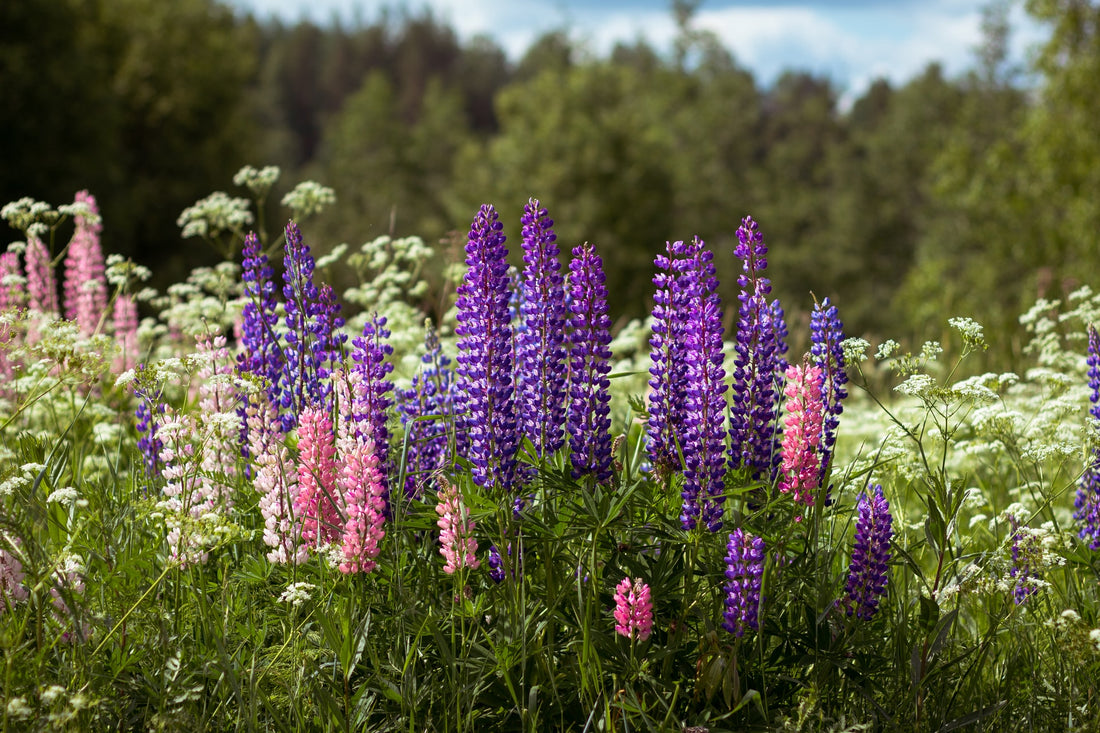The tall, brightly colored flower spires of Lupines are just one of the reasons they are a popular garden flower. There are hundreds of species and cultivars to choose from, and many Lupines are native to North America. Lupines impressive flower display deserves a space in the garden where it can be seen by all.
About Lupines
The majority of Lupine species are from North and South America, but a few are also from the Mediterranean. They are tall, with erect spires of densely packed flowers and attractive green palmate foliage. Lupines are part of the legume family, the same family as peas. Most lupines are perennials but there are also annuals.
Beneficial insects adore Lupine. Pollinators like native bees, butterflies, and moths flock to the soaring flower stalks and prolific blooms. Birds and small mammals appreciate the abundant seeds that appear after flowering.
Most common garden Lupines are hybrids bred in 1937 by George Russell in the UK. These lupines are known as the Russell Hybrids. While the original lupines were blue, Russell bred them to be many other colors. Curiously, if you allow the Russell lupines to self-seed they will revert back to blue after a few years.
The draw of lupines isn't just their 2-7 foot tall flower spikes; their leaves are also captivating. Each leaf cluster is a set of 7-10 leaflets that radiate out from a central point, creating a whorled effect. Leaf coloring ranges from green to blue green to grayish green. Lupine flowers are pea-shaped and ascend up the stem in vast numbers. The showy flower stalks bloom above the foliage, creating a stunning visual.
Lupine Varieties
- Russell Lupines in Red, White, and Blue, growing 30-36 inches tall.
- Arroyo Lupine -- Deep blue to purple blooms; grows to 2 feet tall.
- Large Leaf Lupine -- Purple flowers and grows 36-60" tall.
- Riverbank Lupine - A Pacific Northwest native lupine with light purple flowers; grows up to 3 feet tall.
- Sky Lupine -- An annual species with blue flowers and grows 6-20 inches tall.
Lupines FAQ
- Hardy to zones 3-7, dependent on species
- Lupine is planted in fall for spring blooms the following season
- Blooming is late spring into early summer
- Prefer full sun but will be okay in partial shade
- Well-draining soil is a must due to their long taproots
- Drought-tolerant & deer resistant
- Each Lupine plant grows 2-7 feet tall and 1-2 feet wide – give them space! (this is also dependent on type; there are dwarf varieties.)
- Lupine is a nitrogen-fixer; it adds nitrogen back to the soil which is vital for poor soil, disturbed sites, and low-fertility areas. This function is valuable for habitat rehabilitation.
- The lupine plant grows well in containers, pots, and grow bags.
How To Grow Lupine From Seed
The best way to sow lupine is directly in the garden. It doesn't transplant well due to the long taproot. Thankfully, it grows easily and quickly, so it's not an issue to direct sow in the garden.- Soak the seeds in warm water overnight.
- Rake the garden area lightly to remove the top ¼ of soil.
- Scatter the seeds over the soil.
- Walk over the seeds, to press them into the soil – soil to seed contact is essential for the seeds to sprout. The soil temperature tells the seeds when to germinate in spring.
- Gently rake the soil back over the seeds, so they are covered with 1/8” dirt.
- Water well (but not with a high-pressure hose so the seeds don't get disturbed)
Lupine Care
- Taller varieties benefit from staking, especially in high wind locations. Use flower spikes or a trellis.
- Lupines spread by seed, not roots. They do not need to be divided to propagate, and in fact, shouldn't be as it will damage their roots.



